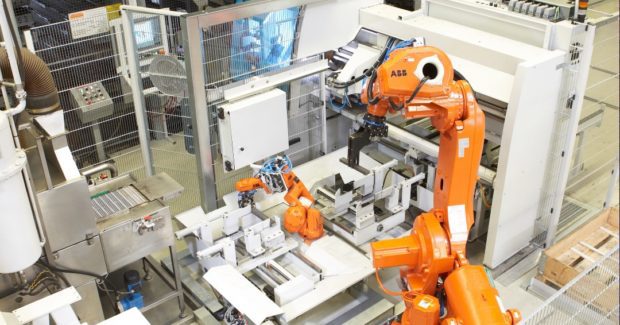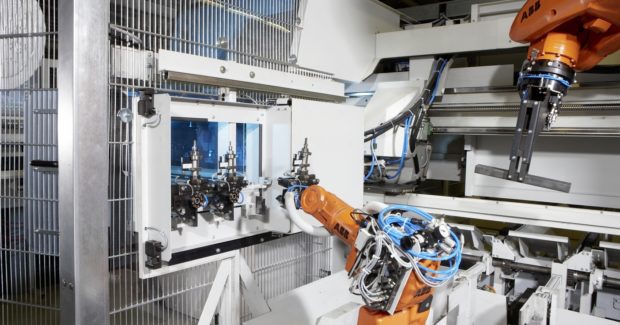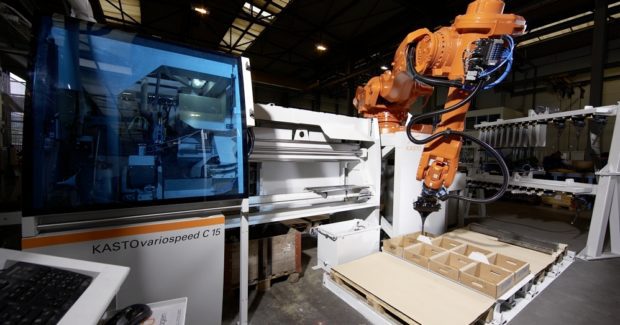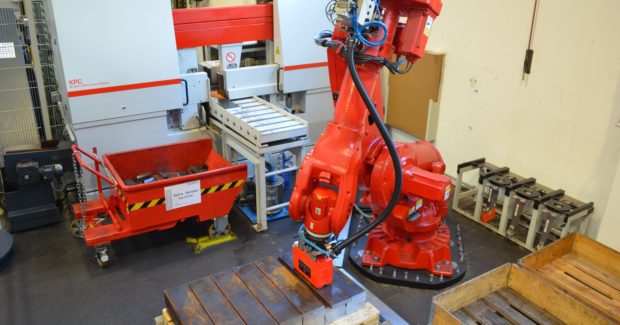Robot-Assisted Sawing for Greater Productivity
Robot-assisted systems are taking over more and more tasks that follow the sawing process, starting with removal of the cut parts and continuing on through deburring, weighing, centring and marking, all the way into sorting and stacking on pallets or in containers.
Posted: February 10, 2018
Automation and robotics are rapidly gaining ground in metalworking, and sawing technology is no exception. Robot-assisted systems are taking over more and more tasks that follow the sawing process, starting with removal of the cut parts and continuing on through deburring, weighing, centring and marking, all the way into sorting and stacking on pallets or in containers. Robots make production more flexible and efficient, improve working conditions and significantly reduce operating costs. In recent years, demands have increased on metal processing across every industry, including the steel trade, automotive manufacturing and machine engineering. Users want greater manufacturing flexibility, from batch sizes of one item to large volume production. The variety of materials and sizes being fabricated is steadily increasing. At the same time, quality standards are rising with continuous pressure to cut costs. To hold their own against international competitors, shops need versatile and efficient systems for a wide variety of production tasks.
COUNTLESS USES FOR ROBOTS
Sawing technology plays a key role in metal processing and offers many opportunities for optimization. More and more operators of sawing systems are intelligently linking their work processes and automating them with robot support. The benefits are obvious: industrial robots are fast, reliable and precise, and, if necessary, they can work 24 hours a day without human intervention. They don’t get tired or fall ill, and they can handle a wide range of tasks when equipped with the necessary tools. “Our robots help us with a number of handling and conveying tasks and efficiently perform many machining steps,” says Volker Bühler, the group manager for robotics at sawing and storage technology specialist KASTO Maschinenbau GmbH & Co. KG (Achern, Germany).
Automation starts with material feeding. The material to be cut is conveyed to the machine by means of roller conveyors or magazines, for example, sparing workers the effort of lifting and carrying and reducing the risk of injuries. Depending on how it is equipped, the sawing machine itself can also run attended. Material is fed to it automatically and an intelligent machine control system sets all parameters, such as cutting length and cutting speed, based on the job data. State-of-the-art production saws can carry out a variety of jobs in sequence, with different materials and diameters, and operate autonomously for long periods.
REMOVAL, MACHINING, STACKING: AUTOMATIC FROM START TO FINISH
Industrial robots provide considerable potential when it comes to handling and processing finished cut parts. For example, they can remove finished parts from the machine, relieving workers of this repetitive task. When equipped with appropriate tools, robots can also perform deburring, chamfering, marking, centring or the measuring of workpieces. Cut parts can be weighed, sorted by size or job, and stacked on pallets or placed in containers. Parts can also be transferred directly to a driverless transport system. “For complex processes involving various work steps, we also use combinations of different robots and clamping devices,” notes Bühler.
When large quantities of material are sawed with only a few different component geometries, it is relatively easy to automate the downstream processes. The situation is different with custom sawing that involves diverse materials and dimensions. “The greater the variety, the harder it is to cover all the possibilities,” explains Bühler. The choice of robot tools is an important factor. A robot must be able to deal with all the objects it encounters while using as few aids as possible. This reduces procurement costs, minimizes idle times and increases productivity. Users have a choice of mechanical, magnetic or vacuum-operated grippers. The grippers should be as compact as possible to give the robot easy access to the cut parts.
SAWING TECHNOLOGY ON COURSE TO INDUSTRY 4.0
With the help of the right components, sawing can be combined with other automated operations to create complex, highly integrated systems that are seamlessly connected in a continuous material flow, including upstream storage as well as downstream handling and processing. For example, KASTO implements combined storage and sawing systems for their customers in which all storage, handling, sawing, marking, palletizing and bundling processes are completely automated – from storage of the raw material to retrieval of the cut parts. The control software can be linked to existing ERP systems like SAP for greater transparency and efficiency. Sawing can be integrated with other processes, like turning or milling, in digitized, self-configured production systems such as envisioned in Germany’s Industry 4.0 initiative.
Automated sawing technology offers significant advantages to users. Many processes can run unattended and much faster, which increases productivity and reduces the need for personnel. It is easier to make up the difference when employees are ill, and robots can keep working even during breaks or after shifts. The result is lower personnel costs and greater flexibility in terms of capacity utilization. Manufacturers can react more easily to order peaks and dramatically reduce idle times. This can make a big difference economically. “We’ve calculated that, depending on the shift model, an investment in an industrial robot with an advanced sawing system pays for itself in less than a year,” states Bühler. “When you consider that systems like this are used for more than ten years on average, users can reduce their operating costs for a very long time.”
https://youtu.be/b8BYhgewGT0
Robot technology also helps to improve working conditions. It relieves employees of heavy, tiring and monotonous tasks. The risk of accidents and injuries is reduced. Moreover, the cut parts are of better quality, because robots machine them with equal precision, sort them reliably and stack them neatly. This provides benefits not only for operators of automatic sawing facilities, but also for their customers.
KASTO, Inc., 3002 Venture Court, Export, PA 15632-8949, 724-325-5600, www.kasto.com.














